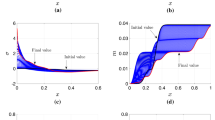Abstract
We interpret the probability rule of the CSL collapse theory to mean to mean that the scalar field which causes collapse is the gravitational curvature scalar with two sources, the expectation value of the mass density (smeared over the GRW scale a) and a white noise fluctuating source. We examine two models of the fluctuating source, monopole fluctuations and dipole fluctuations, and show that these correspond to two well-known CSL models. We relate the two GRW parameters of CSL to fundamental constants, and we explain the energy increase of particles due to collapse as arising from the loss of vacuum gravitational energy.
Similar content being viewed by others
References and remarks
This prescription is crude because it is based upon the undefined notion of measurement by an apparatus to determine which events can occur and upon the imprecise statement “after the measurement is completed” to indicate when the event and its accompanying collapse take place (note that the Born rule gives, not anabsolute probability per second of an event, but rather theconditional probability of an eventif one occurs). The currently fashionable “decoherence” schemes provide no essential improvement, possessing comparable undefined and imprecise features. See, e.g., F. Dowker and A. Kent,Phys. Rev. Lett. 75, 3038 (1995); I. Giardina and A. Rimini, “On the existence of inequivalent classical domains,” Pavia preprint FNT/T-95/22; P. Pearle,A. J. Phys. 35, 742 (1967) and inQuantum-Classical Correspondence, Proceedings of the 4th Drexel Symposium on Quantum Nonintegrability, D. H. Feng and B. L. Hu, eds. (World Scientific, Singapore, 1995): E. Squire, inStochastic Evolution of Quantum States in Open Systems and in Measurement Processes, L. Diosi and B. Lukacs, eds. (World Scientific, Singapore, 1994); A. Venugopalan,Phys. Rev. A 50, 2742 (1994).
P. Pearle,Phys. Rev. A 39, 2277 (1989).
G. C. Ghirardi, P. Pearle, and A. Rimini,Phys. Rev. A 42, 78 (1990).
G. C. Ghirardi and A. Rimini, inSixty-Two Years of Uncertainty, A. Miller, ed. (Plenum, New York, 1990), p. 167; P. Pearle, inSixty-Two Years of Uncertainly, A. Miller, ed. (Plenum, New York, 1990), p. 193; G. C. Ghirardi and P. Pearle, inProceedings of the Philosophy of Science Foundation 1990, Volume 2, A. Fine, M. Forbes, and L. Wessels, eds. (PSA Association, Michigan, 1992), p. 19 and p. 35; P. Pearle, inThe Interpretation of Quantum Theory: Where Do We Stand, L. Accardi, ed. (Istituto della Enciclopedia Italiana, Roma, 1994), p. 187.
L. Ballentine,Phys. Rev. A 43, 9 (1991). The energy creation was realized from the beginning by GRW,(6) and indeed one factor in their choice of parameters was to keep it below experimental limits.
G. C. Ghirardi, A. Rimini, and T. Weber,Phys. Rev. D 34, 470 (1986):Phys. Rev. D 36, 3287 (1987);Found. Phys. 18, 1 (1988); J. S. Bell, inSchrodinger-Centenary Celebration of a Polymath, C. W. Kilmister, ed. (Cambridge University Press, Cambridge, 1987) and inSpeakable and Unspeakable in Quantum Mechanics (Cambridge University Press, Cambridge, 1987), p. 167.
T. W. B. Kibble, inQuantum Gravity II, A Second Oxford Symposium, C. J. Isham, R. Penrose, and D. W. Sciama, eds. (Clarendon Press, Oxford. 1981), p. 63.
D. N. Page and C. D. Geilker,Phys. Rev. Lett. 47, 979 (1981).
L. Diosi,Phys. Rev. A 40, 1165 (1989).
G. C. Ghirardi, R. Grassi, and A. Rimini,Phys. Rev. A 42, 1057 (1990).
This energy gain is compensated by a loss of gravitational potential energy supplied by the vacuum. The appearance of, e.g., a Planck mass monopole means that the vacuum supplies both the Planck mass-energy and the (negative) monopole-particle mutual gravitational energy. The energy gain of a particle during its brief period of acceleration by the monopole comes from a decrease of this mutual gravitational energy. Thus, the subsequent absorption of the monopole by the vacuum entails a net loss of gravitational energy of the vacuum.
F. Karolyhazy,Nuovo Cimento A 42, 1506 (1966); F. Karolyhazy, A Frenkel, and B. Lukacs, inPhysics as Natural Philosophy, A. Shimony and H. Feshbach. eds. (M.I.T. Press. Cambridge. 1982). p. 204; inQuantum Concepts in Space and Time, R. Penrose and C. J. Isham, eds. (Clarendon, Oxfod, 1986), p. 109; A. Frenkel,Found. Phys. 20, 159 (1990).
R. Penrose, inQuantum Concepts in Space and Time. R. Penrose and C. J. Isham, eds. (Clarendon Press. Oxford, 1986), p. 129;The Emperor's New Mind (Oxford University Press, Oxford, 1992):Shadows of the Mind (Oxford University Press, Oxford, 1994).
P. Pearle,Phys. Rev. A 48, 913 (1993); inPerspectives on Quantum Reality. R. Clifton, ed. (Kluwer Academic, Dordrecht, 1996).
P. Pearle and E. Squires,Phys. Rev. Lett. 73, 1 (1994).
B. Collett, P. Pearle, F. Avignone, and S. Nussinov,Found. Phys. 25, 1399 (1995).
Author information
Authors and Affiliations
Rights and permissions
About this article
Cite this article
Pearle, P., Squires, E. Gravity, energy conservation, and parameter values in collapse models. Found Phys 26, 291–305 (1996). https://doi.org/10.1007/BF02069474
Received:
Issue Date:
DOI: https://doi.org/10.1007/BF02069474




